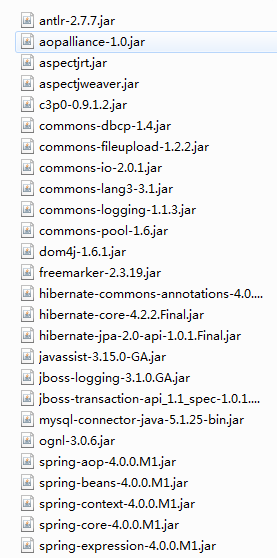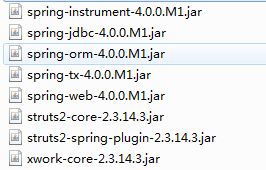1.加入spring
1)加入jar包
2)配置web.xml applicationContext.xml (监听器)
3)加入spring的配置文件:aop context tx bean
1.加入hibernate
1.1建立持久化类,和其对应的xxx,hbm。xml文件,生产对应的数据表
1.2spring 整合hibernate
1)加入jar包
2)类路径下加入hibernate.cfg.xml文件.其中配置hibernate的基本配置
3)建立持久化类和对应的xxx.hbm。xml
4)和spring整合
a)加入c3p0和mysql的驱动
b)在spring的配置文件中配置:数据源,sessionFactory,声明式事务
5)启动项目,会看到生产对应的数据表
3.加入struts2
1)加入jar包,有重复的包,删除版本低的包
2)在web。xml文件中配置Struts2的Filter
3)加入配置文件Struts.xml
4)整合Spring
a)加入Struts2的Spring插件的jar包
b)在Spring的配置文件中正常配置Action,并设置Scope为prototype
c)在Struts2的配置文件中Action时,class属性指向该Action在IOC中的id
注:以下代码的首行仅仅起到标记注释作用,开发时请去掉!
<!-- web.xml -->
<?xml version="1.0" encoding="UTF-8"?>
<web-app xmlns:xsi="http://www.w3.org/2001/XMLSchema-instance"
xmlns="http://java.sun.com/xml/ns/javaee"
xsi:schemaLocation="http://java.sun.com/xml/ns/javaee http://java.sun.com/xml/ns/javaee/web-app_3_0.xsd"
id="WebApp_ID" version="3.0">
<!-- 配置Spring的监听器 -->
<context-param>
<param-name>contextConfigLocation</param-name>
<param-value>classpath:applicationContext*.xml</param-value>
</context-param>
<listener>
<listener-class>org.springframework.web.context.ContextLoaderListener</listener-class>
</listener>
<!-- 配置Struts2的Filter -->
<filter>
<filter-name>struts2</filter-name>
<filter-class>org.apache.struts2.dispatcher.ng.filter.StrutsPrepareAndExecuteFilter</filter-class>
</filter>
<filter-mapping>
<filter-name>struts2</filter-name>
<url-pattern>/*</url-pattern>
</filter-mapping>
</web-app>
<!-- applicationContext.xml -->
<?xml version="1.0" encoding="UTF-8"?>
<beans xmlns="http://www.springframework.org/schema/beans"
xmlns:xsi="http://www.w3.org/2001/XMLSchema-instance"
xmlns:aop="http://www.springframework.org/schema/aop"
xmlns:context="http://www.springframework.org/schema/context"
xmlns:tx="http://www.springframework.org/schema/tx"
xsi:schemaLocation="http://www.springframework.org/schema/beans http://www.springframework.org/schema/beans/spring-beans.xsd
http://www.springframework.org/schema/aop http://www.springframework.org/schema/aop/spring-aop-3.2.xsd
http://www.springframework.org/schema/context http://www.springframework.org/schema/context/spring-context-3.2.xsd
http://www.springframework.org/schema/tx http://www.springframework.org/schema/tx/spring-tx-3.2.xsd">
<!-- 导入资源文件 -->
<context:property-placeholder location="classpath:db.properties"/>
<!-- 配置c3p0数据源 -->
<bean id="dataSource" class="com.mchange.v2.c3p0.ComboPooledDataSource">
<property name="user" value="${jdbc.user}"></property>
<property name="password" value="${jdbc.password}"></property>
<property name="driverClass" value="${jdbc.driverClass}"></property>
<property name="jdbcUrl" value="${jdbc.jdbcUrl}"></property>
<property name="initialPoolSize" value="${jdbc.initPoolSize}"></property>
<property name="maxPoolSize" value="${jdbc.maxPoolSize}"></property>
</bean>
<!-- 配置SessionFactory -->
<bean id="sessionFactory" class="org.springframework.orm.hibernate4.LocalSessionFactoryBean">
<property name="dataSource" ref="dataSource"></property>
<property name="configLocation" value="classpath:hibernate.cfg.xml"></property>
<property name="mappingLocations" value="classpath:xby/ssh/entities/*.hbm.xml"></property>
</bean>
<!-- 配置spring声明式事务 -->
<!-- 1.配置hibernate的事务管理器 -->
<bean id="transactionManager" class="org.springframework.orm.hibernate4.HibernateTransactionManager">
<property name="sessionFactory" ref="sessionFactory"></property>
</bean>
<!-- 2.配置事务属性 -->
<tx:advice id="txAdvice" transaction-manager="transactionManager">
<tx:attributes>
<tx:method name="get*" read-only="true"/>
<tx:method name="*"/>
</tx:attributes>
</tx:advice>
<!-- 3.配置事务切入点->再把事务属性和事务切入点关联起来 -->
<aop:config>
<aop:pointcut expression="execution(* xby.ssh.service.*.*(..))" id="txPointcut"/>
<aop:advisor advice-ref="txAdvice" pointcut-ref="txPointcut"/>
</aop:config>
</beans>
<!-- applicationContext-beans.xml -->
<?xml version="1.0" encoding="UTF-8"?>
<beans xmlns="http://www.springframework.org/schema/beans"
xmlns:xsi="http://www.w3.org/2001/XMLSchema-instance"
xsi:schemaLocation="http://www.springframework.org/schema/beans http://www.springframework.org/schema/beans/spring-beans.xsd">
<bean id="employeeDao" class="xby.ssh.dao.EmployeeDao">
<property name="sessionFactory" ref="sessionFactory"></property>
</bean>
<bean id="employeeService" class="xby.ssh.service.EmployeeService">
<property name="employeeDao" ref="employeeDao"></property>
</bean>
<bean id="employeeAction" class="xby.ssh.actions.EmployeeAction"
scope="prototype">
<property name="employeeService" ref="employeeService"></property>
</bean>
</beans>
<!-- struts.xml -->
<?xml version="1.0" encoding="UTF-8" ?>
<!DOCTYPE struts PUBLIC
"-//Apache Software Foundation//DTD Struts Configuration 2.0//EN"
"http://struts.apache.org/dtds/struts-2.0.dtd">
<struts>
<!-- 该属性设置Struts2是否支持动态方法调用,该属性的默认值是true -->
<constant name="struts.enable.DynamicMethodInvocation" value="false"/>
<constant name="struts.devMode" value="true" />
<package name="default" namespace="/" extends="struts-default">
<action name="emp-*" class="employeeAction"
method="{1}">
<result name="list">/WEB-INF/views/emp-list.jsp</result>
</action>
</package>
</struts>
<!-- hibernate.cfg.xml -->
<?xml version="1.0" encoding="UTF-8"?>
<!DOCTYPE hibernate-configuration PUBLIC
"-//Hibernate/Hibernate Configuration DTD 3.0//EN"
"http://hibernate.sourceforge.net/hibernate-configuration-3.0.dtd">
<hibernate-configuration>
<session-factory>
<!-- 配置基本熟属性 -->
<!-- 数据库方言 -->
<property name="hibernate.dialect">org.hibernate.dialect.MySQL5Dialect </property>
<!-- 显示sql语句 -->
<property name="hibernate.show_sql">true</property>
<property name="hibernate.format_sql">true</property>
<!-- 生产数据表的策略-->
<property name="hibernate.hbm2ddl.auto">update</property>
<!-- 二级缓存-->
</session-factory>
</hibernate-configuration>
//db.propertites jdbc.user=root jdbc.password=root jdbc.driverClass=com.mysql.jdbc.Driver jdbc.jdbcUrl=jdbc:mysql://localhost:3306/ssh jdbc.initPoolSize=5 jdbc.maxPoolSize=10


以上是所有的jar包,完全版,经测试没有问题。有需要者,可私信我~